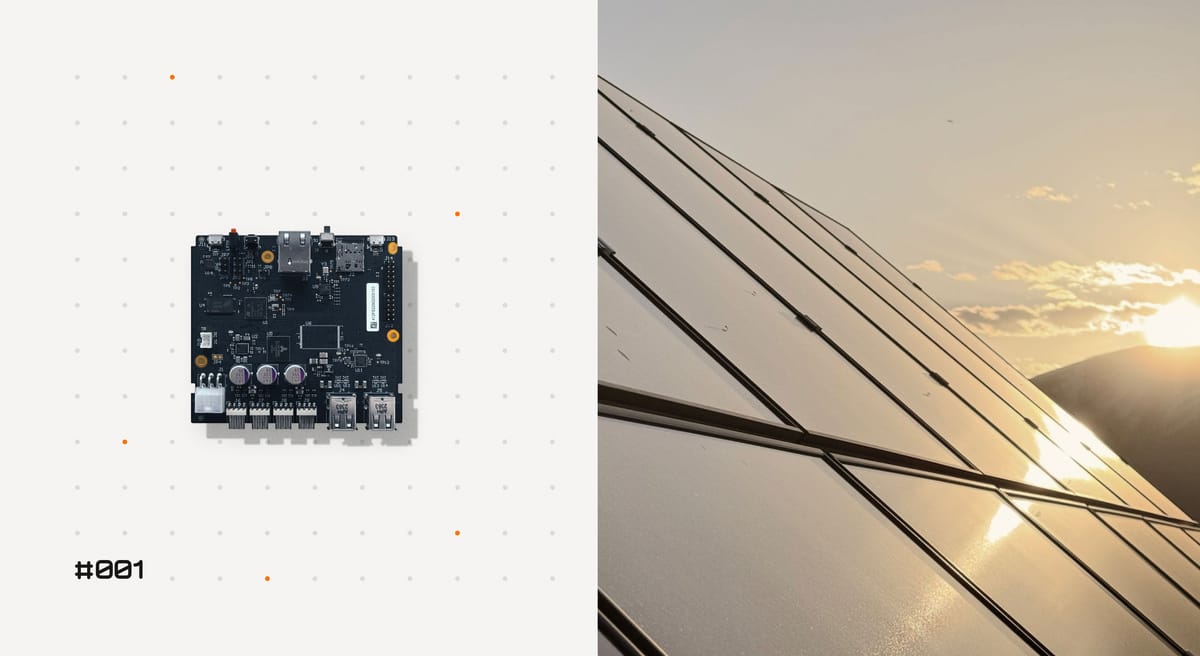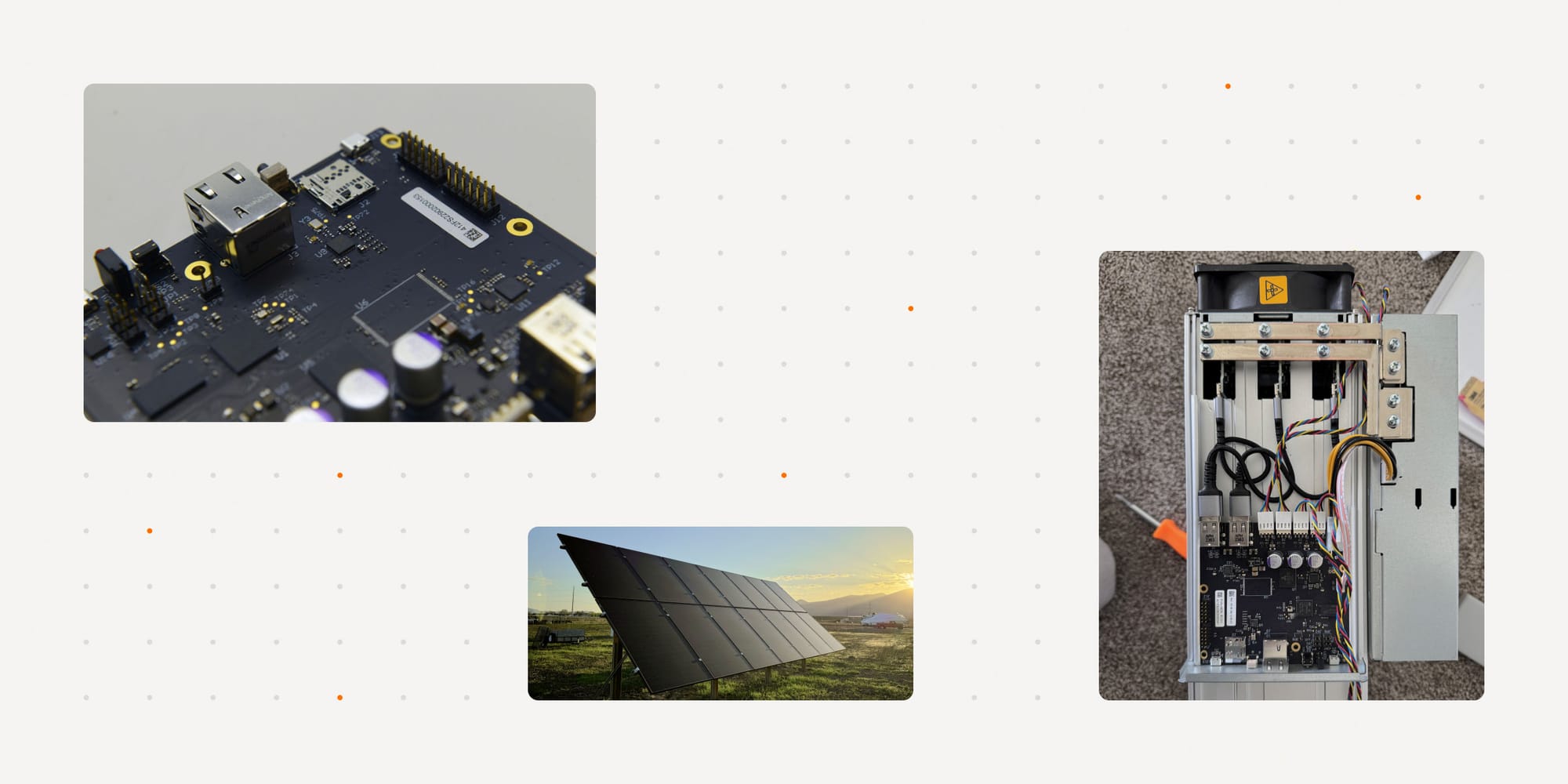
Possible Futures #001
How one off-grid miner turned a stranded energy problem into heat and bitcoin
Somewhere in northern Utah, about an hour’s drive outside Salt Lake City, 20 chickens roam freely around an acre-and-a-half off-grid homestead. In the winter, they drink water kept liquid by a simple heating element that draws power from a couple standalone solar panels sitting alongside their chicken run.
“We used to live in Salt Lake City, in an older part of town. Our specific area had a lot of problems with infrastructure,” says SmithOffGrid, an engineer, inventor, and the homestead proprietor.
“We’d have a power outage every few months, there were multiple incidents of gas leaks, and water mains were continuously breaking.”
Partly out of frustration and partly out of a belief that a better way was possible, he and his family started looking into more self-sufficient options and researching solar energy. They found their current location, cleared out some rocks, and over time built up a main system that ultimately let them leave the power grid.
The system itself is made up of three separate solar arrays: one 14 400W-panel in-ground array (5600W total), an “on-ground” array made up of 5 380W panels resting on PVC pipe (1900W total), and another 7 380W panels (2660W total) mounted on the roof of a chicken run. All of this feeds into a 12kW inverter–the “heart” of the off-grid system.
Today, that system powers an almost entirely off-grid home and full suite of electric appliances–from washer and dryer, to electric range and microwave, to heat pump for hot water, heating in winter, and air conditioning in summer. The homeowners capture some of the energy they don’t immediately use in their uninsulated garage, in a battery bank with 30kWh of capacity, letting them use electricity during the evenings and stretches of cloudy weather.
“The amount of solar power coming in varies a ton throughout the year and day-to-day,” he says. “Some days you get a ton and some days you get almost none.”
“Since our goal is total self sufficiency, we have to build around the worst case. So while in the summer time we’re producing more than we use, in the winter time or with bad weather, we're often only barely producing enough.”
Stranded energy, giveaway power, and cold-weather battery degradation
At peak sun times, even during the winter months, SmithOffGrid’s panels produce far more energy than they can use. On days with full sun, his batteries tend to fill up by noon, leaving his panels just sitting there, effectively unused for most of the day–and at some of the peak hours for energy collection, no less. All that energy was essentially going to waste, leaving his whole system operating at less-than-optimal efficiency most afternoons.
He first considered selling his excess power back to the grid, but with his own battery setup, that meant effectively donating excess power to the power company with no financial return for his efforts.
“If you’re never going to pull from the grid, it’s not worth sending it back,” says SmithOffGrid.
“The power company only gives you credits that you can pull from. It works for people without batteries, who essentially use the grid as their battery–sending excess power to the grid in the summer and pulling what they need in the winter. But if you have a battery, there’s no financial incentive at all.”
A third issue with the home solar setup is that, when battery temps dip below freezing, the battery can’t charge, making it impossible to store additional energy. If the battery isn’t already full, it just doesn’t get full, even if the sun is shining. During the cold winters of northern Utah, this can be a real problem–on top of the more general long-term battery degradation that prolonged exposure to extreme temperatures can cause.
Stranded energy mining for bitcoin and heat re-use
The Venn diagram of SmithOffGrid’s energy system inefficiencies–the excess energy going to waste, the lack of financial incentive to send power back to the grid, and the need to keep his batteries above a certain temperature to ensure maximum uptime and system longevity–all overlap at bitcoin mining.
“It seemed like the miner could solve a few different problems,” said SmithOffGrid.
“We have excess power and need to keep the batteries warm. We could burn energy on a heater, or we could run a miner to heat the space and get paid back in bitcoin.”
So that’s what they decided to do. SmithOffGrid signed up to be part of Proto’s Mining Development Kit (MDK) beta program–a small program designed to gather early feedback from builders with the goal of enabling them to develop novel mining use cases.

The MDK hardware used during beta is an early prototype made up of three hashboards, each equipped with 100 5-nm BZM2 ASIC chips and a controller board pre-loaded with Proto’s custom firmware (future iterations, and Proto’s forthcoming mining systems, will use internally-developed 3-nm mining chips, which are expected to greatly improve performance and system efficiency). Each hashboard came equipped with an embedded controller, which allowed a greater degree of flexibility controlling the ASICs. The kit also included an API for easy integration with miner management software solutions, and the hardware components were designed to be compatible with most existing chassis, PSUs, fans, and cables.
“The idea of mining bitcoin is really cool–just the fact that it could heat and do all of these other things for us. And the MDK, exploring other ways to use power, with some coding, seemed like a fun challenge.”
From integration test to programmatic, automated mining
After installing the MDK hardware into a commonly available chassis, upgrading firmware, and signing up for a mining pool, SmithOffGrid ran a first integration test, using a combination of MDK tools, some custom code, a raspberry pi, and the MQTT broker that his solar monitoring and control system provides. He wrote custom code to listen for certain events as triggers for mining activity to start and stop.
The initial integration test triggered mining when the solar system itself turned on–essentially proof of concept for event-based mining, and that his solar system and the MDK could effectively “talk” to each other. Spoiler alert: it worked.
Since the ultimate goal is to have the miner only run when the system is capturing excess energy and not powering any other loads, the next challenge was to code for different events related to state of battery charge instead of the simple existence of solar input.
Early tests triggered the miner to turn on around 75% charge and off at 50%. But turning on at that level meant the system never fully charged–and letting batteries fall to 50% meant that, if it was cloudy the next day (or the next few days), there’d be a situation where the whole system could be depleted, and he’d be forced to run a backup generator to power the home’s essentials, sort of defeating the purpose the whole experiment.
After some tinkering and testing a range of values, SmithOffGrid landed on 95% and 90% as the ideal on/off triggers respectively. At these levels, even with the miner running (2kW of use when running), the battery would still reach 100% charge and conserve enough power to avoid depleting the system quickly during stretches of cloudy weather.
Key learnings and areas of future exploration
An unanticipated issue with the mining setup itself is the amount of power the miner draws in a sleep state–about 150W “out of the box,” so to speak. While not much on its face, it adds up, and can draw down more than 10% (3.6kWh) of his existing battery capacity over a day’s time while doing nothing to mine bitcoin or heat the space.
Working on the assumption that cooling fans were the main power draw at rest, the Proto team worked to adjust the fan curve to be lower–from 10% at sleep to 2%. This reduced the overall noise of the machine, but only brought power usage down to 130W. As it turns out, the power supply itself is the main draw, not the fans, and adjusting that down lower is not possible with the current setup–valuable feedback for future iterations of MDK software.
“At something like 40W, I’d be willing to let it run all the time,” he says. “But the ideal situation is one where sleep means zero usage. Then it could be totally autonomous, do its own thing, turn itself on. I’m thinking about an external switch or relay to make something like that work with existing capabilities.”
Apart from the system itself, SmithOffGrid is interested in the option to lottery mine rather than mine with a pool. The miner as essentially a stand-in for a space heater is enough benefit on its own, and the chance to earn an entire block reward–even if that chance is very, very small–is more attractive than the few dollars worth of BTC here and there that one solo miner currently earns as part of a larger pool.
The system also has yet to run through a summer, when heat is very much not an issue (in fact, cooling may become one) and surplus energy should be in great supply.
“It feels good to get as much usage as possible out of the system,” he says. “When the battery is full and you still have an untapped energy source, the answer had been, ‘Let’s run the lights! Charge everything! Run the dryer!’ With the miner, it’s fun to see usage even if it’s high and covered.”
To learn more about Proto, visit proto.xyz. To learn more about SmithOffGrid’s experiments, check out https://www.youtube.com/@SmithOffGrid.
Authors
Stay in the loop
Subscribe to receive new post alerts and provide direct feedback to our team.